Can men wear women’s shoes? It’s a question that pops up more often than you might think. Whether it’s due to size availability, comfort, or simply style preference, many men wonder if crossing the traditional gender line in footwear is practical—or even a good idea.
While men’s and women’s shoes are designed differently in sizing, width, and cushioning, wearing women’s shoes isn’t impossible. In fact, with a few adjustments and the right knowledge, men can comfortably find shoes that fit, look good, and support their feet.
Can Men Wear Women’s Shoes?
Yes, men can wear women’s shoes. But how? Seems confusing right? Let’s look at a few important things to consider before you decide to do so yourself:
1. Is There a Difference Between Men’s and Women’s Shoes?
Before deciding to cross over in shoe choices, it helps to understand the key differences between men’s and women’s shoes. While they may look similar at first glance, design features vary significantly.
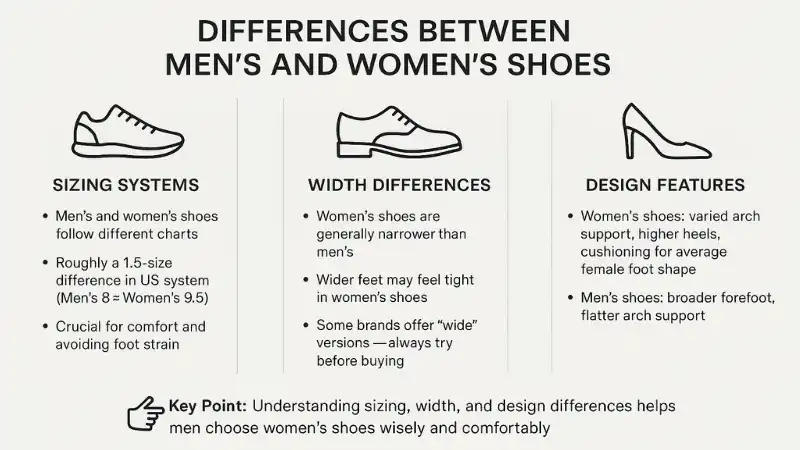
- Sizing Systems
Men’s and women’s shoes follow different sizing charts, with roughly a 1.5-size difference in the US system. For example, a men’s size 8 roughly equals a women’s size 9.5. Keeping this in mind is crucial for comfort and avoiding foot strain.
- Width Differences
Women’s shoes are generally narrower than men’s. If you have wider feet, a direct swap can feel tight or uncomfortable. Some brands offer “wide” versions, but trying before buying is always recommended.
- Design Features
Women’s shoes often have different arch support, heel height, and cushioning tailored for the average female foot shape. Men’s shoes, on the other hand, tend to accommodate a broader forefoot and flatter arch.
Understanding these differences answers the common question: is there a difference between men’s and women’s shoes? Awareness helps you choose wisely and comfortably when experimenting with cross-wearing.
For tips on selecting the right shoe for your foot type, see How to Choose the Right Nursing Shoes.
2. Can Men Wear Women’s Shoes Comfortably?
The short answer is yes—men can wear women’s shoes comfortably, but it depends on factors like foot shape, shoe type, and proper sizing adjustments. With a little guidance, men can enjoy style and comfort without compromise.
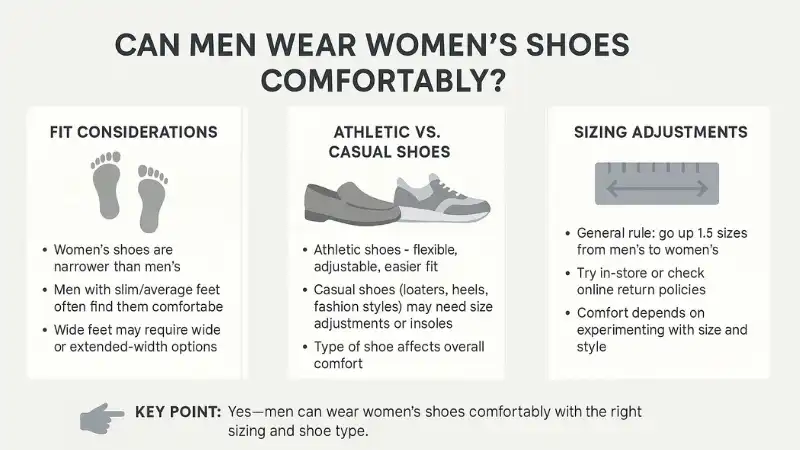
● Fit Considerations
Women’s shoes are typically narrower than men’s, which means men with slim or average-width feet often find them surprisingly comfortable. However, men with wider feet may need to pay extra attention to width sizing. Some brands offer wide or extended-width options in women’s shoes, so it’s worth exploring those to ensure a secure, pain-free fit.
● Athletic vs. Casual Shoes
Athletic shoes—like running sneakers, cross-trainers, or gym shoes—tend to be made with flexible materials and adjustable laces, making them much easier for men to wear. On the other hand, casual or fashionable shoes, such as loafers or heels, may require sizing up or adding cushioned insoles to avoid discomfort. Understanding the type of shoe helps determine whether it will work comfortably for daily wear.
● Sizing Adjustments
A helpful rule of thumb is to go up about 1.5 sizes from your usual men’s size when trying women’s shoes. Trying shoes in-store or checking online return policies ensures you can experiment without the risk of a poor fit.
Curious about sporty options? Many men find that men wearing women’s sneakers isn’t just possible—it can also be more stylish and functional than men’s versions. Whether it’s for casual wear or workouts, choosing the right fit and design makes all the difference.
For more detailed tips on cushioning, support, and long-lasting comfort, see Best Sneakers for Nurses.
3. Why Do Men Wear Women’s Shoes?
You might be wondering: why do men wear women’s shoes? The answer goes beyond fashion—there are practical, financial, and personal reasons that make this choice more common than you might think.
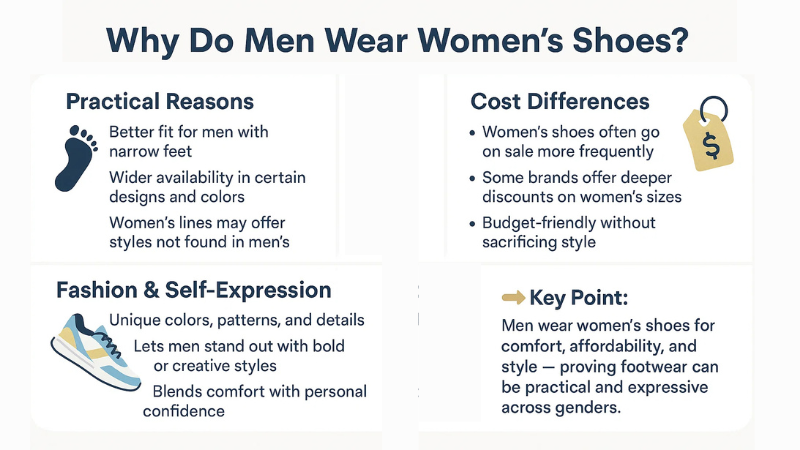
● Practical Reasons
For some men, women’s shoes simply fit better. Men with narrower feet or those who struggle to find the right size in men’s shoes often find that women’s styles provide a more comfortable and secure fit. Availability can also play a role—certain designs, colors, or trends might only be offered in the women’s line, making cross-wearing the easiest way to get the desired look.
● Cost Differences
Affordability is another factor. Women’s shoes often go on sale more frequently, and some brands offer better discounts in women’s sizes. Men looking to save without compromising on style or quality may find that opting for women’s shoes is a practical, budget-friendly choice.
● Fashion and Self-Expression
Fashion and personal expression are equally important. Sneakers, casual shoes, and even boots designed for women sometimes feature colors, patterns, or details that aren’t available in men’s shoes. Men who want to stand out or experiment with style can use women’s shoes as a way to make a unique fashion statement.
Wearing women’s shoes is a reflection of personal taste and confidence. By choosing the right fit, design, and style, men can enjoy both comfort and self-expression in a single pair of shoes.
For more insights on footwear choices and styling tips, check out Why Do Nurses Wear White Shoes.
4. Can Women Wear Men’s Shoes Too?
Absolutely! Women can also enjoy wearing men’s shoes, and doing so can be practical for comfort, style, and performance.
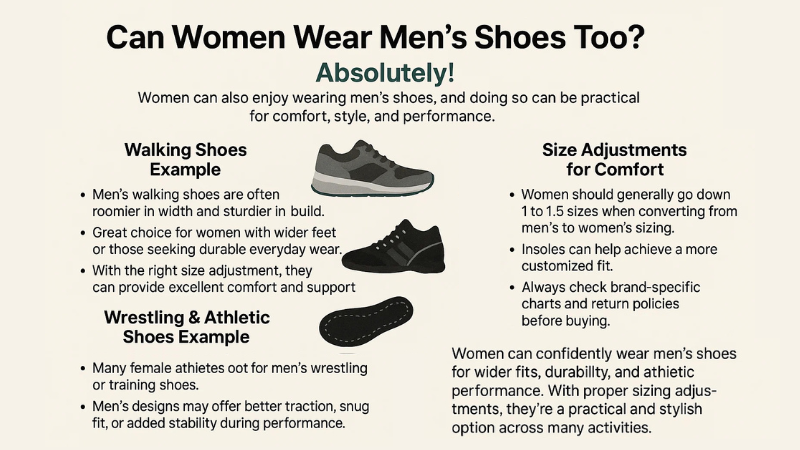
- Walking Shoes Example
For everyday walking shoes, women often find men’s options roomier in width and sturdier in build. This is particularly helpful for those with wider feet. Using size adjustments ensures a comfortable fit without compromising foot support.
- Wrestling Shoes Example
Athletic shoes like wrestling or training shoes in men’s sizes may offer better traction or a snugger fit for competitive activities. Women who need extra space or stability often prefer men’s versions.
- Size Adjustments for Comfort
Just like men trying women’s shoes, women should check sizing charts and consider going down half a size or using insoles for the perfect fit. Trying shoes in-store or reviewing return policies online is always recommended.
For choosing shoes that match your activity level, see How to Choose the Right Nursing Shoes.
5. Pros and Cons of Wearing Opposite Gender Shoes
Wearing shoes designed for the opposite gender can be a smart choice, but it comes with both advantages and potential drawbacks. Knowing what to expect can help you make informed decisions that balance style, comfort, and practicality.
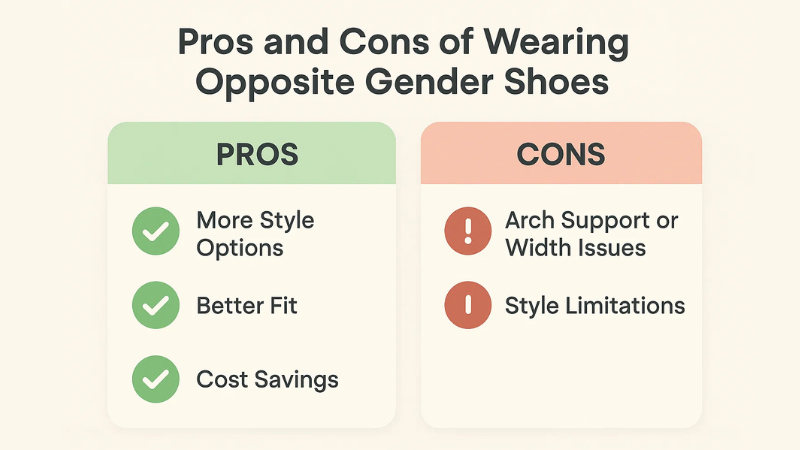
Pros
- More Style Options:
One of the biggest benefits is access to a wider range of colors, patterns, and designs. Men can explore women’s styles for unique looks, while women can find men’s shoes that offer bold or minimalist designs not commonly available in women’s lines.
- Better Fit:
Foot shape varies widely, and sometimes the opposite gender’s shoes provide a superior fit. Men with narrower feet or women with wider feet may discover that these shoes feel more comfortable than traditional options.
- Cost Savings:
Shoes in the opposite gender’s line can sometimes be more affordable. Whether it’s sales, discounts, or brand pricing, men and women can find options that save money without compromising on quality.
Cons
- Arch Support or Width Issues:
Not all shoes are created equal in terms of foot structure. Wearing the wrong design for your arch, heel, or width can lead to discomfort over time, especially during long periods of walking or standing.
- Style Limitations:
Certain designs may not be suitable for professional environments, uniforms, or specific dress codes. While fashion-forward, these choices might not always align with workplace expectations.
By weighing these pros and cons, you can decide when cross-wearing is practical and when it’s better to stick with traditional sizing. The key is to balance comfort, style, and functionality for your everyday needs.
For more insights on comfort and foot health, check out Foot Care Tips for Nurses.
Tips for Cross-Wearing Shoes Without Issues
Wearing shoes from the opposite gender doesn’t have to be complicated. With a few simple strategies, you can enjoy comfort, style, and proper support without any hassles.
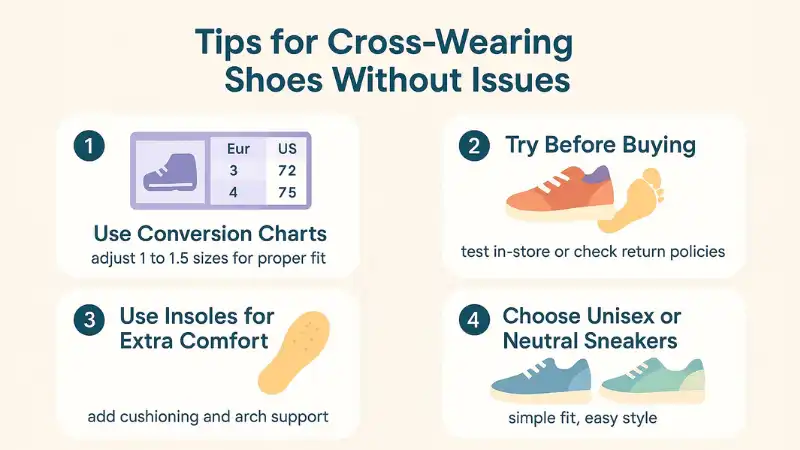
1. Use Conversion Charts
Always check men’s-to-women’s size charts before making a purchase. Even a small adjustment—typically 1 to 1.5 sizes up—can make a huge difference in how the shoes fit. Taking the time to convert sizes correctly helps prevent discomfort and wasted money.
2. Try Before Buying
Whenever possible, test shoes in-store. Walking around for a few minutes can reveal tight spots or pressure points that might not be obvious while standing. If shopping online, choose retailers with flexible return or exchange policies to ensure a safe fit.
3. Use Insoles for Extra Comfort
Custom or cushioned insoles can help balance differences in arch support, heel height, and cushioning between men’s and women’s shoes. They provide extra comfort, reduce foot fatigue, and make cross-wearing shoes much more practical for long hours of wear.
4. Choose Unisex or Neutral Sneakers
Many sneakers and casual shoes are already unisex, designed to fit a wide range of foot shapes. Opting for these styles reduces guesswork, ensures a better fit, and allows you to enjoy both comfort and style without worrying about sizing complications.
By following these tips, cross-wearing shoes becomes practical, safe, and even stylish—letting you prioritize comfort without sacrificing fashion.
For more advice on choosing shoes that feel great all day, see Best Shoes for Nurses.
Conclusion
So, can men wear women’s shoes? Absolutely—as long as size, width, and support are considered, crossing traditional shoe labels can be both comfortable and stylish. Many shoes, especially sneakers, are already unisex, making it easier to find a perfect fit without compromise.
Remember, comfort and foot health always come first. Focus on the right size, proper cushioning, and supportive insoles rather than strictly following gender labels. With these tips, you can enjoy more style options, better fits, and even cost savings.
FAQs About Wearing Opposite Gender Shoes
Can men wear women’s sneakers every day?
Yes, men can wear women’s sneakers daily as long as the size and width are correct. Look for shoes with good arch support and cushioning to prevent discomfort over long periods.
Do women’s shoes last as long as men’s?
Durability depends on materials and construction rather than gender. High-quality women’s shoes can last just as long as men’s shoes, especially if properly maintained.
Can women wear men’s wrestling shoes safely?
Yes, women can wear men’s wrestling shoes safely by checking the fit and considering size adjustments. Properly fitted shoes ensure support, traction, and performance.
Why are women’s shoes narrower than men’s?
Women’s shoes are designed to match the average female foot shape, which tends to be narrower in the forefoot and heel. Men with narrow feet may find these fits more comfortable.
Is it bad for your feet to wear opposite-gender shoes?
Not if the size, width, and support are correct. Always try shoes before buying and consider insoles for extra comfort. Poorly fitted shoes, however, can lead to discomfort or foot problems over time.

Leave a Reply